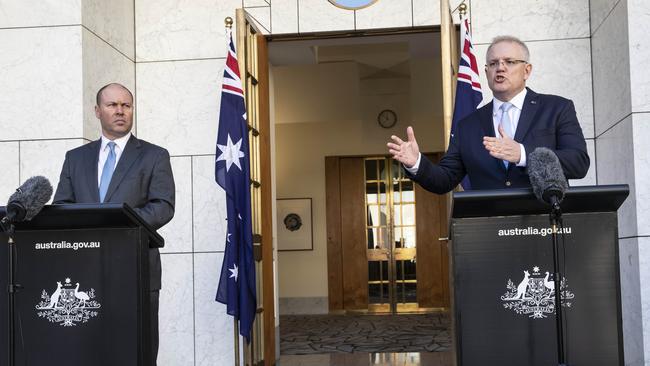
The long-awaited policy announcement has an optimistic view of economic recovery. It assumes Australia can combat the second wave of COVID-19 without NSW succumbing and with Victoria’s lockdown doing the job over the next six weeks. The entire economic strategy hinges upon medical success.
This statement ends the emergency response to the crisis but retains the emergency framework. This is its real meaning. It constitutes another defining pointer to the government’s character, the influence of Treasury and the balance Frydenberg, as Treasurer, has struck. It accepts the historic transformation in economic policy — that with interest rates at rock bottom, it is government fiscal action that is crucial in determining the future.
The ethos is that Australia must learn to live and work with COVID-19 but not abandon hope. Without hope, there is no enduring recovery. The government’s three pivotal assumptions are a steady economic recovery, success in containing virus outbreaks and significant ongoing temporary support for businesses and individuals well into 2021 but tapering as recovery develops.
This is no V-shaped recovery. JobKeeper and JobSeeker extend beyond the September deadline in an effort to avert the feared labour market “cliff” at that time. This decision was essential because of the damaged labour market and the imperative to hold public confidence together.
As Morrison said, the assumption is that “the virus will plot its own course”, that there is “no silver bullet” and that the response must be practical not ideological. Morrison and Frydenberg have tried to strike the balance. Their assumption of economic recovery is seen in the hefty cut in the degree of financial support, but they still tell Australians “we will have your back”. The political risk is whether people accept the inevitability of reduced benefits.
The dilemma is that even with economic recovery, unemployment will increase further. Morrison said on Tuesday that his focus is the unemployment rate, with the effective jobless rate being 11.3 per cent (with Victoria in lockdown for some time) while the official rate is 7.4 per cent, the highest in 21 years.
Reserve Bank governor Philip Lowe warned on Tuesday that while “we have now turned the corner” there were cross currents in the employment outlook and the path ahead “is expected to be bumpy”. In short, take nothing for granted.
The parameters around JobKeeper tell the story. It sustains 3.5 million individuals, but this is predicted to fall to 1.4 million during the December quarter and then a million in the March quarter of 2021. This reflects Treasury confidence that, given the fairly strict criteria, fewer businesses will be eligible as economic activity grows stronger.
The Treasury review showed JobKeeper largely met its goals of keeping businesses and jobs alive, retaining the link between employee and company and offering income support. To June 23, outlays have been $20.3bn.
The payment has been targeted, going to businesses that had an average decline in turnover of 37 per cent compared with a year ago. “There is no evidence of widespread business closures,” Treasury said. A remarkable situation … so far.
Significantly, Treasury said the case for extending the scheme beyond September was “strong”. But the extension should be “time-limited”, not permanent. It also said the extension should be based not on the “most affected” industries but on turnover decline applied across the board.
The payments are tapered to encourage the transition to recovery. Today’s $1500 a fortnight goes to $1200 in the December quarter and $1000 in the March quarter. For part-timers, the rates will be $750 and $650 respectively.
The government’s confidence in economic recovery is reflected in the cost to budget. The cost of JobKeeper is $70bn to the end of September, and the new six monthly extension will cost an additional $16.6bn. It is easy to lose perspective. The JobKeeper program has been the most costly program in Australia’s economic history and the cost of the extension, while far lower, remains substantial by any standard.
The message is unmistakeable. The government cares about deficits and debt but, while imposing a constraint on policy, deficits and debt no longer drive policy. This is the correct judgment. Laments by observers that this is hypocritical given the Coalition’s attitude more than 10 years ago during the GFC are irrelevant.
As Deloitte Access Economics partner Chris Richardson has argued, getting the economy to grow again is the key to addressing deficit and debts. Lowe was explicit: fiscal expansion “is entirely manageable and affordable and it’s the right thing to do in the national interest”. Labor will take heart from this in pushing for the government to go further.
Because JobKeeper is a demand-driven scheme, Treasury estimates may be unreliable (given its recent blunder) and the budgetary forecasts released on Thursday are going to display red ink on an unnerving scale not seen in the postwar era. Offset against this is the Morrison government’s mantra that the pandemic is a “once-in-100-year” challenge thereby demanding unprecedented policy.
Treasury highlighted the “adverse effects” of JobKeeper in blunting the incentive to work or take on additional work hours — this applied to part-timers and casuals who saw an increase in their income and also employees stood down but receiving payments. A range of employers reported difficulty getting people to work. Treasury said of JobSeeker, the unemployment benefit, that the $1124.50 maximum fortnightly payment available to single, no-dependent recipients “effectively forms a new reservation wage or floor” that can limit labour availability. It reminds us that the hastily devised scheme was far short of optimal.
This is the context for the reduction in the JobSeeker supplement of $550 to $250 a fortnight from September 24 until December 31. The government was never going to retain the full supplement post-September. The elevated benefit remains at about $1100 until September 24, and is then reduced to about $800 at an ongoing additional cost to the budget of $3.8bn.
But the government has avoided any decision on a new and permanent increased JobSeeker rate post-December, for which there is immense political support. With unemployment certain to rise, even given economic recovery, this is a highly sensitive issue.
Morrison was firm on the reasoning. He said the public understands “that JobSeeker at the elevated levels cannot go on forever — it has always been our view that it has to taper back”. The higher support levels “were never designed to be permanent” and the government’s view was that we need “to work ourselves off these supports”.
But Morrison also sent an unequivocal message: “I want to be very clear”, he said. “I am leaning heavily into the notion” that “there would obviously need to be some continuation of the COVID supplement post-December.” So the government accepts the unemployment benefit cannot revert to its pre-pandemic level. Unsurprisingly, Morrison wants to terminate that debate. He will monitor the economic recovery before making a final decision on the JobSeeker rate.
The government will face inevitable criticism that it has not provided a fuller picture of the economic recovery strategy. The reason is obvious — those decisions are not yet taken. But the Prime Minister sent one further strong message on Tuesday: as financial support is reduced, industrial relations flexibility is the essential ingredient to facilitate job creation. And whether or not it strikes an agreement with the ACTU, the government will put its desired IR reform proposals to the parliament.




Scott Morrison has become the ultimate practical centrist as crisis manager. Morrison and Josh Frydenberg seek to hold the middle ground — they are pushing hard to get the economy into recovery while extending, at reduced rates, the pillars of financial support in the form of JobKeeper and JobSeeker.